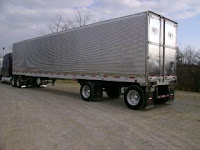This past weekend, I spent more time than usual in my father's work truck and came to some new realizations. It is a 2005 GMC Sierra 2500 pickup - nothing that I have ever thought of as special, but with the five areas of ergonomic research on my mind, I examined its design more closely than I ever have before. I concluded that, though I don't believe there is such thing as a perfect design, there is such thing as a successful design, and this particular GMC is a successful ergonomic design.
In the first area of ergonomic research, safety, this GMC has many features that just make sense, yet are not standard in every vehicle. In addition to the safety measures that are now standard in all new vehicles such as seatbelts and airbags, simple things like the window controllers having to be pulled up rather than pressed to roll the window up contribute to this truck's safety. This feature prevents children or animals from rolling the window up on themselves with their knees or paws when they have their head out the window. Whether we want to admit it or not, such issues do come up. Secondly, the radio can be controlled by buttons on the steering wheel. This means a person can adjust the volume or station without removing their hands from the wheel. As we all know, it only takes looking away for a second for an accident to occur. Next, the headlights turn on by themselves when it detects it is getting dark or foggy. This means that the driver doesn't have to worry about forgetting to turn on their headlights to be seen by other drivers or to be able to see what is in front of them in all conditions. The headlights will be on when they need to be, something that makes driving safer for everyone. Furthermore, the driver cannot be locked out of the car while the keys are in the ignition because the truck doors will not lock. They work automatically, however, when they should. For example, when the truck is put into gear, the doors lock. When it is put into park, they unlock. These features provide for a sense of security as a driver that one's passengers are secure while the car is in motion. Additionally, visor extensions on the sun visors provide for extra protection against driving into the sun, improving the driver's ability to see and thus chances of driving safely. All these features seem simple and logical to me, but strangely, many newer vehicles (such as our family's 2006 Dodge Ram) do not have any of them.
In the field of comfort, there is little I would change about the interior, something I don't say often. The seats are comfortable and padded well. The head rests are soft and adjustable in order to fit every passenger correctly. The truck also has a powerful air conditioning and heating system that actually circulates air to the back seat where there aren't any vents. It also conveniently displays the temperature outside on the rear view mirror and the artist and song playing on the radio on the dash.
This truck is also very easy to use. The gas and brake petals are sensitive enough that it is easy to stop and get going without much effort. Since, as I said above, the lights go on automatically, there is one less thing to think about adjusting before starting the car. The same element that makes the radio safe also makes it convenient because it takes very little effort to make adjustments on the steering wheel. The settings for cruise control are conveniently located right next to the wheel, and the seats and steering column are easy to adjust to fit any driver. This means that once they are comfortable, there is little to think about other than driving the car safely.
In terms of performance, the truck has presented no issues. After five years of use, none of the parts or features have broken yet. It not only holds up to normal wear and tear, but it also has not wavered in the face of having to carry the weight of equipment. The engine has presented no problems and , though it has gone through a few transmissions in its short life, there is little to complain about. It performs when it is asked to and gets my father from point A to point B; little more than that can be expected.
Aesthetics is the last and least important area or ergonomic research, but it is one in which this truck does not fall short. The body is smooth with rounded edges making it automatically register as more aerodynamic and visually appealing. Its silver bumper is emphasized by the contrast in colors from the dark blue body. The silver strip along both sides of the truck gives it a feeling of unity because of the continuity of the silver line that flows from bumper to bumper. and the proximity of the silver to the other silver elements in the wheels. Everything is slightly larger in scale than it would be on a car to look proportional on the larger truck. The grill seems to be the focal point of the front for a few reasons. First, it is in the middle of the two headlights that draw one's eyes. It also is black which presents contrast from the silver and blue that are the two main hues. Finally, the red GMC logo that is present in the center of the black automatically draw one's eye to the grill.

All five areas of ergonomic research have led me to only one conclusion. That, though no design is perfect, this truck's design was indeed successful because it serves its purpose and caters to the user well.
























